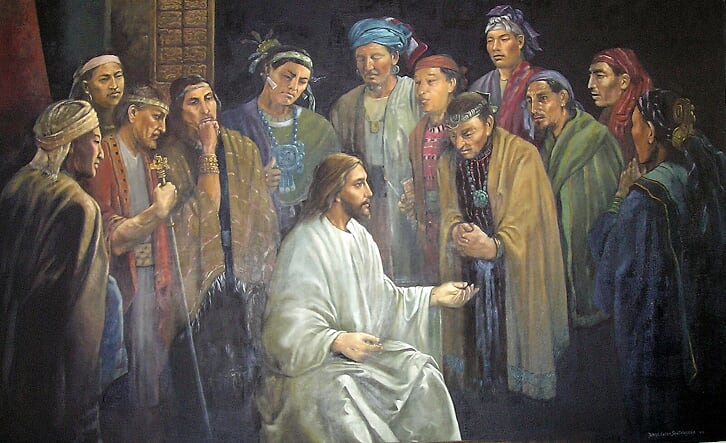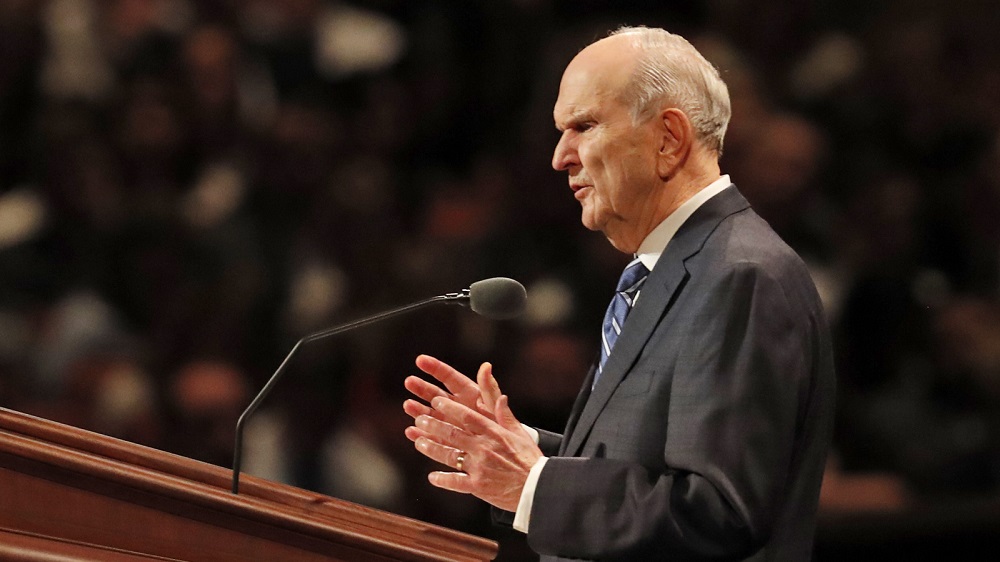/ KnoWhys / KnoWhy #482
Why Must Christ’s True Church Be Called after His Name?

Post contributed by BMC Team
November 6, 2018
D&C KnoWhy #482

“Therefore ye shall call the church in my name.”
The Know
Following the visit of the resurrected Jesus to the New World, His disciples traveled about preaching His gospel. They then “gathered together and were united in mighty prayer and fasting” (3 Nephi 27:1). In response, “Jesus came and stood in the midst of them, and said unto them: What will ye that I shall give unto you?” (v. 2). A question must have arisen among the people, for the disciples asked to know by what name they should call Christ’s Church. Jesus answered, “ye shall call the church in my name” (v. 7). In association with this commandment, Jesus taught several principles that help establish and clarify its doctrinal basis. These principles become unmistakably clear in the following summaries.
Christ’s Followers Should Avoid Murmuring and Disputations

Although Jesus was surely happy to give further light and knowledge to His people, He wasn’t pleased that this question had arisen because of “disputations” among them. (3 Nephi 27:3). With emphatic concern, he asked, “Verily, verily, I say unto you, why is it that the people should murmur and dispute because of this thing?” (v. 4). While asking questions and counseling together is good, arguing over points in Christ’s true doctrine or Church is not.
The Scriptures Already Have the Answer
Rather than simply delivering a new revelation, Jesus directed his disciples to a teaching already contained in their scriptures. He asked, “Have they [the people] not read the scriptures, which say ye must take upon you the name of Christ, which is my name?” (3 Nephi 27:5). The instruction to take upon oneself the name of Christ is found in several previous Nephite scriptures, including 2 Nephi 31:13; Mosiah 5:8, 10; Mosiah 25:23; Alma 34:38; and Alma 46:18.
We Must Do All Things in the Name of Christ
Jesus further taught His disciples that “whatsoever ye shall do, ye shall do it in my name” (3 Nephi 27:7). He then asked, “And how be it my church save it be called in my name? For if a church be called in Moses’ name then it be Moses’ church; or if it be called in the name of a man then it be the church of a man; but if it be called in my name then it is my church” (3 Nephi 27:8).
This principle provides the underlying basis for Christ’s commandment regarding the name of His Church. Names carried great significance in the ancient world: they were intentionally given, carefully used, and scrupulously guarded, as in the commandment to use the name of the Lord properly and not take it in vain (Exodus 20:7). When members of Christ’s Church covenant to follow Him, they take upon themselves His name, both individually and collectively. They become witnesses of Jesus Christ and emissaries of His true gospel. As such, everything they do should be a reflection of Christ’s good name.
Christ’s Church Must Be Built upon His True Gospel
Jesus clarified, however, that simply naming a church after Him isn’t enough. He will only accept a church named after Him “if it so be that they are built upon my gospel” (3 Nephi 27:8). For this reason, the members of Christ’s true Church each have a responsibility to follow the true gospel, upon which His Church is always built. Otherwise, any misconduct would result in a misappropriation or denigration of His name.
The Why
On August 16, 2018, the First Presidency of The Church of Jesus Christ of Latter-day Saints released a statement from the living prophet, President Russell M. Nelson. He declared, “The Lord has impressed upon my mind the importance of the name He has revealed for His Church, even The Church of Jesus Christ of Latter-day Saints. We have work before us to bring ourselves in harmony with His will.”1

Following this statement, the Church provided an updated style guide “which provides direction on how to properly refer to The Church of Jesus Christ of Latter-day Saints.”2 Among other things, the guidelines stipulate that the name Mormon, although it is a name that Latter-day Saints revere and honor, should not be used as a reference to The Church of Jesus Christ of Latter-day Saints or the members who belong to it.3 In every way, each of the principles that Christ taught about the name of His church in 3 Nephi 27 can apply to how Latter-day Saints and others understand and receive this counsel.
Christ’s Followers Should Avoid Murmuring and Disputations
Christ’s counsel about disputations certainly applies today, with various social media platforms making it easier than ever to fall into contentious arguments and debates. Some may feel that the full name of The Church of Jesus Christ of Latter-day Saints is too long for practical use. Others might suppose that trying to get millions of people to adjust the way they refer to the Church or its members is too great a task and not worth the effort.
Whatever our personal feelings may be at the moment, Jesus taught His disciples that they should avoid murmuring and disputing over this matter. As we allow the “Spirit of Christ” to direct our opinions and feelings (Moroni 7:16), eventually we will come into a “unity of the faith” (Ephesians 4:13).
The Scriptures Already Have the Answer
President Nelson clarified that this recent announcement does not reflect a name change for either the Church or its members. Instead, it merely corrects an error that has crept into the Church over time.4 All along, the scriptures have stated clearly that Christ’s followers should be called after His name. Moreover, the specific name by which Christ’s Church should be called in these latter-days is given in Doctrine and Covenants 115:4: “For thus shall my church be called in the last days, even The Church of Jesus Christ of Latter-day Saints.”
In 1990, then Elder Nelson explained, “Note carefully the language of the Lord. He did not say, ‘Thus shall my church be named.’ He said, ‘Thus shall my church be called.’ … Before any other name is considered to be a legitimate substitute, the thoughtful person might reverently consider the feelings of the Heavenly Parent who bestowed that name.”5
We Must Do All Things in the Name of Christ
The principle that Christ’s followers should do “all things in the name of Christ” is what guides the naming of Christ’s Church in these latter days, just as it did in ancient times (3 Nephi 27:7). Although Mormon was a great man, the Church does not belong to him, just like it does not belong to Moses (v. 8). The Church belongs to Jesus Christ, whose holy name its members take upon themselves at baptism and reverence throughout their lives. Elder M. Russell Ballard asked, “Do we realize how blessed we are to take upon us the name of God’s Beloved and Only Begotten Son? Do we understand how significant that is? The Savior’s name is the only name under heaven by which man can be saved (see 2 Nephi 31:21).”6
A majority of people are still not sure that Mormons are Christian. … Surely it would be easier for them to understand that we believe in and follow the Savior if we referred to ourselves as members of The Church of Jesus Christ of Latter-day Saints. In this way, those who hear the name Mormon will come to associate that word with our revealed name and with people who follow Jesus Christ.7
Christ’s Church Must Be Built upon His True Gospel
Through the prophet Joseph Smith, the Lord restored the true gospel of Jesus Christ to the earth.8 As part of this restoration, Joseph Smith was also given priesthood authority and was commanded to reestablish the Church of Christ.9 Recognizing Jesus Christ’s direct hand in restoring both His gospel and His Church to the earth can help its members better understand why the lives they lead must be worthy of the name by which they are called. It can also help people see why the Lord Himself affirmed that The Church of Jesus Christ of Latter-day Saints is “the only true and living church upon the face of the whole earth, with which I, the Lord, am well pleased” (Doctrine and Covenants 1:30; emphasis added).
Further Reading
Russell M. Nelson, “The Correct Name of the Church,” Ensign, November 2018, online at lds.org.
M. Russell Ballard, “The Importance of a Name,” Ensign, November 2011, online at lds.org.
Boyd K. Packer, “Guided by the Holy Spirit,” Ensign, May 2011, online at lds.org.
Russell M. Nelson, “‘Thus Shall My Church Be Called’,” Ensign, May 1990, online at lds.org.
1. See “The Name of the Church” Newsroom, August 16, 2018, online at mormonnewsroom.org.
2. “Style Guide — The Name of the Church,” Newsroom, accessed September 20, 2018, online at mormonnewsroom.org.
3. “Style Guide — The Name of the Church,” Newsroom, accessed September 20, 2018, online at mormonnewsroom.org.
4. Russell M. Nelson, “The Correct Name of the Church,” Ensign, November 2018, online at lds.org.
5. Russell M. Nelson, “‘Thus Shall My Church Be Called’,” Ensign, May 1990, online at lds.org.
6. M. Russell Ballard, “The Importance of a Name,” Ensign, November 2011, online at lds.org. See also, Mosiah 5:8–10.
7. Ballard, “The Importance of a Name,” online at lds.org.
8. Book of Mormon Central, “Why Did the Lord Quote the Book of Mormon When Reestablishing the Church? (3 Nephi 11:24),” KnoWhy 282 (March 3, 2017).
9. See Book of Mormon Central, “What Did the Book of Mormon Teach Early Church Leaders about the Order and Offices of the Priesthood? (Alma 13:8),” KnoWhy 330 (June 23, 2017); Book of Mormon Central, “What Does the Book of Mormon Teach about the Priesthood? (Mosiah 23:17),” KnoWhy 289 (March 20, 2017); Book of Mormon Central, “Why Did Joseph And Oliver Seek Authority To Baptize? (3 Nephi 11:24–25),” KnoWhy 279 (February 4, 2017).

